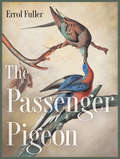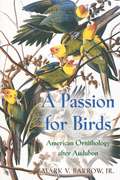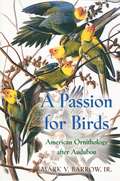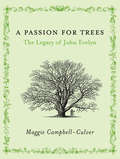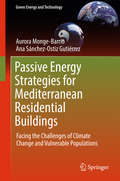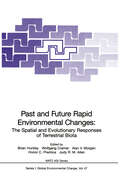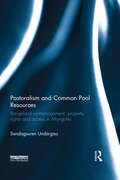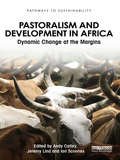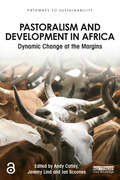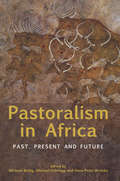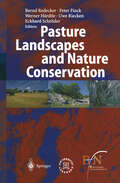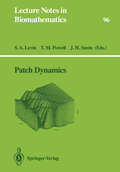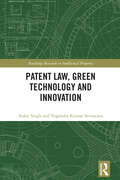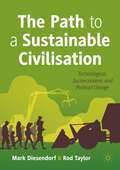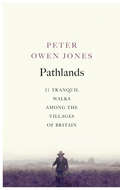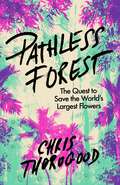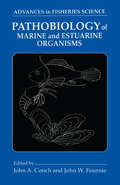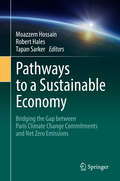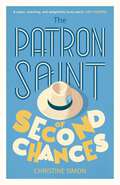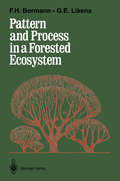- Table View
- List View
The Passenger Pigeon
by Errol FullerAt the start of the nineteenth century, Passenger Pigeons were perhaps the most abundant birds on the planet, numbering literally in the billions. The flocks were so large and so dense that they blackened the skies, even blotting out the sun for days at a stretch. Yet by the end of the century, the most common bird in North America had vanished from the wild. In 1914, the last known representative of her species, Martha, died in a cage at the Cincinnati Zoo. This stunningly illustrated book tells the astonishing story of North America's Passenger Pigeon, a bird species that—like the Tyrannosaur, the Mammoth, and the Dodo—has become one of the great icons of extinction. Errol Fuller describes how these fast, agile, and handsomely plumaged birds were immortalized by the ornithologist and painter John James Audubon, and captured the imagination of writers such as James Fenimore Cooper, Henry David Thoreau, and Mark Twain. He shows how widespread deforestation, the demand for cheap and plentiful pigeon meat, and the indiscriminate killing of Passenger Pigeons for sport led to their catastrophic decline. Fuller provides an evocative memorial to a bird species that was once so important to the ecology of North America, and reminds us of just how fragile the natural world can be. Published in the centennial year of Martha’s death, The Passenger Pigeon features rare archival images as well as haunting photos of live birds.
A Passion for Birds: American Ornithology after Audubon (PDF)
by Mark BarrowIn the decades following the Civil War--as industrialization, urbanization, and economic expansion increasingly reshaped the landscape--many Americans began seeking adventure and aesthetic gratification through avian pursuits. By the turn of the century, hundreds of thousands of middle-and upper-class devotees were rushing to join Audubon societies, purchase field guides, and keep records of the species they encountered in the wild. Mark Barrow vividly reconstructs this story not only through the experiences of birdwatchers, collectors, conservationists, and taxidermists, but also through those of a relatively new breed of bird enthusiast: the technically oriented ornithologist. In exploring how ornithologists struggled to forge a discipline and profession amidst an explosion of popular interest in natural history, A Passion for Birds provides the first book-length history of American ornithology from the death of John James Audubon to the Second World War. Barrow shows how efforts to form a scientific community distinct from popular birders met with only partial success. The founding of the American Ornithologists' Union in 1883 and the subsequent expansion of formal educational and employment opportunities in ornithology marked important milestones in this campaign. Yet by the middle of the twentieth century, when ornithology had finally achieved the status of a modern profession, its practitioners remained dependent on the services of birdwatchers and other amateur enthusiasts. Environmental issues also loom large in Barrow's account as he traces areas of both cooperation and conflict between ornithologists and wildlife conservationists. Recounting a colorful story based on the interactions among a wide variety of bird-lovers, this book will interest historians of science, environmental historians, ornithologists, birdwatchers, and anyone curious about the historical roots of today's birding boom.
A Passion for Birds: American Ornithology after Audubon
by Mark BarrowIn the decades following the Civil War--as industrialization, urbanization, and economic expansion increasingly reshaped the landscape--many Americans began seeking adventure and aesthetic gratification through avian pursuits. By the turn of the century, hundreds of thousands of middle-and upper-class devotees were rushing to join Audubon societies, purchase field guides, and keep records of the species they encountered in the wild. Mark Barrow vividly reconstructs this story not only through the experiences of birdwatchers, collectors, conservationists, and taxidermists, but also through those of a relatively new breed of bird enthusiast: the technically oriented ornithologist. In exploring how ornithologists struggled to forge a discipline and profession amidst an explosion of popular interest in natural history, A Passion for Birds provides the first book-length history of American ornithology from the death of John James Audubon to the Second World War. Barrow shows how efforts to form a scientific community distinct from popular birders met with only partial success. The founding of the American Ornithologists' Union in 1883 and the subsequent expansion of formal educational and employment opportunities in ornithology marked important milestones in this campaign. Yet by the middle of the twentieth century, when ornithology had finally achieved the status of a modern profession, its practitioners remained dependent on the services of birdwatchers and other amateur enthusiasts. Environmental issues also loom large in Barrow's account as he traces areas of both cooperation and conflict between ornithologists and wildlife conservationists. Recounting a colorful story based on the interactions among a wide variety of bird-lovers, this book will interest historians of science, environmental historians, ornithologists, birdwatchers, and anyone curious about the historical roots of today's birding boom.
A Passion For Trees: The Legacy Of John Evelyn
by Maggie Campbell-CulverGiven the extent of his influence on 17th-century life, and his lasting impact on the British landscape it is remarkable that no book has been written before about John Evelyn. He was a longstanding friend of Samuel Pepys (who wrote of him, ' A most excellent person he is, and must be allowed a little for conceitedness; but he may well be so, being a man so much above others.'), a founder-member of the Royal Society and a prolific writer and diarist. He was an early advocate of the garden city but his most important work was Sylva: a Discourse of Forest Trees. Sylva was presented to the Royal Society to promote the planting of timber trees 'for the supply of the Navy, the employment and advantage of the poor as well as the ornamenting of the nation.' He was responsible for the first great raft of tree-planting and for a great influx of tree introductions to Britain.Maggie Campbell-Culver's book, like Sylva, has at its core a section detailing the characteristics, history and uses of 33 trees incorporating the advice Evelyn gave and demonstrating its relevance still in the 20th-century. Not only was Evelyn probably the first horticultural writer to show an appreciation of the aesthetic benefits of trees in our landscape, he is shown to be a founder-father of the modern conservation movement.
Passive Energy Strategies for Mediterranean Residential Buildings: Facing the Challenges of Climate Change and Vulnerable Populations (Green Energy and Technology)
by Aurora Monge-Barrio Ana Sánchez-Ostiz GutiérrezThis book presents an approach to energy-efficient building design, which takes into account the most important challenges in climate change mitigation and adaptation in Southern Europe. It outlines a specific approach related to residential buildings and their intergenerational and vulnerable occupants, such as ageing population and users in fuel poverty. It also focuses on the use of passive energy measures throughout the year, and on pursuing a realistic and affordable approach to the efficient rehabilitation of resilient residential buildings.In addition, the book presents case studies that include surveys, monitoring, and simulation of residential buildings in Spain and other Southern European representative locations, in order to go further on the study of this challenging topic.
Past and Future Rapid Environmental Changes: The Spatial and Evolutionary Responses of Terrestrial Biota (Nato ASI Subseries I: #47)
by Brian Huntley Wolfgang Cramer Alan V. Morgan Honor C. Prentice Judy R. M. AllenNumerous experts including ecologists, geneticists, paleontologists and climatologists, investigate the response of terrestrial organisms to changes in their environment. The volume comprises an introductory and a final chapter by the editors as well as another 35 contributions. These are divided into six sections: 1. past environmental changes - the late-Quaternary; 2. spatial responses to past changes; 3. mechanisms enabling spatial responses; 4. evolutionary responses to past changes; 5. mechanisms enabling evolutionary responses; 6. predicted future environmental changes and simulated responses. The overwhelming and unanimous conclusion of all contributors is that forecasted global environmental changes pose a severe threat to the integrity of ecosystems worldwide and to the survival of at least some species.
Pastoralism and Common Pool Resources: Rangeland co-management, property rights and access in Mongolia
by Sandagsuren UndargaaThe grazing of animals on common land and associated property rights were the original basis of the concept of "the tragedy of the commons". Drawing on the classic work of Elinor Ostrom and the readings of political ecology, this book questions the application of exclusive property rights to mobile pastoralism and rangeland resource governance. It argues that this approach inadequately represents property relations in the context of Mongolian pastoralism. The author presents an in-depth exploration and analysis of mobile pastoral production and resource management in Mongolia. The country is widely considered to be a prime example of successful and resilient common pool resource management, but now faces a dilemma as policy advocates attempt to adjust historical pastoralism to a modern property regime framework. The book strengthens understanding of the complex and multilateral considerations involved in natural resource governance and management in a mobile pastoralist context. It considers the implications for common pool resource management and pastoral societies in Africa, Russia and China and includes recommendations for formulating national policy.
Pastoralism and Common Pool Resources: Rangeland co-management, property rights and access in Mongolia
by Sandagsuren UndargaaThe grazing of animals on common land and associated property rights were the original basis of the concept of "the tragedy of the commons". Drawing on the classic work of Elinor Ostrom and the readings of political ecology, this book questions the application of exclusive property rights to mobile pastoralism and rangeland resource governance. It argues that this approach inadequately represents property relations in the context of Mongolian pastoralism. The author presents an in-depth exploration and analysis of mobile pastoral production and resource management in Mongolia. The country is widely considered to be a prime example of successful and resilient common pool resource management, but now faces a dilemma as policy advocates attempt to adjust historical pastoralism to a modern property regime framework. The book strengthens understanding of the complex and multilateral considerations involved in natural resource governance and management in a mobile pastoralist context. It considers the implications for common pool resource management and pastoral societies in Africa, Russia and China and includes recommendations for formulating national policy.
Pastoralism and Development in Africa: Dynamic Change at the Margins (Pathways to Sustainability)
by Andy Catley Jeremy Lind Ian Scoones Jeremy LindeckOnce again, the Horn of Africa has been in the headlines. And once again the news has been bad: drought, famine, conflict, hunger, suffering and death. The finger of blame has been pointed in numerous directions: to the changing climate, to environmental degradation, to overpopulation, to geopolitics and conflict, to aid agency failures, and more. But it is not all disaster and catastrophe. Many successful development efforts at ‘the margins’ often remain hidden, informal, sometimes illegal; and rarely in line with standard development prescriptions. If we shift our gaze from the capital cities to the regional centres and their hinterlands, then a very different perspective emerges. These are the places where pastoralists live. They have for centuries struggled with drought, conflict and famine. They are resourceful, entrepreneurial and innovative peoples. Yet they have been ignored and marginalised by the states that control their territory and the development agencies who are supposed to help them. This book argues that, while we should not ignore the profound difficulties of creating secure livelihoods in the Greater Horn of Africa, there is much to be learned from development successes, large and small. This book will be of great interest to students and scholars with an interest in development studies and human geography, with a particular emphasis on Africa. It will also appeal to development policy-makers and practitioners.
Pastoralism and Development in Africa: Dynamic Change at the Margins (Pathways to Sustainability)
by Author UnknownOnce again, the Horn of Africa has been in the headlines. And once again the news has been bad: drought, famine, conflict, hunger, suffering and death. The finger of blame has been pointed in numerous directions: to the changing climate, to environmental degradation, to overpopulation, to geopolitics and conflict, to aid agency failures, and more. But it is not all disaster and catastrophe. Many successful development efforts at ‘the margins’ often remain hidden, informal, sometimes illegal; and rarely in line with standard development prescriptions. If we shift our gaze from the capital cities to the regional centres and their hinterlands, then a very different perspective emerges. These are the places where pastoralists live. They have for centuries struggled with drought, conflict and famine. They are resourceful, entrepreneurial and innovative peoples. Yet they have been ignored and marginalised by the states that control their territory and the development agencies who are supposed to help them. This book argues that, while we should not ignore the profound difficulties of creating secure livelihoods in the Greater Horn of Africa, there is much to be learned from development successes, large and small. This book will be of great interest to students and scholars with an interest in development studies and human geography, with a particular emphasis on Africa. It will also appeal to development policy-makers and practitioners.
Pastoralism in Africa: Past, Present and Future
by Michael Bollig Michael Schnegg Hans-Peter WotzkaPastoralism has shaped livelihoods and landscapes on the African continent for millennia. Mobile livestock husbandry has generally been portrayed as an economic strategy that successfully met the challenges of low biomass productivity and environmental variability in arid and semi-arid environments. This volume focuses on the emergence, diversity, and inherent dynamics of pastoralism in Africa based on research during a twelve-year period on the southwest and northeast regions. Unraveling the complex prehistory, history, and contemporary political ecology of African pastoralism, results in insight into the ingenuity and flexibility of historical and contemporary herders.
Pasture Landscapes and Nature Conservation
by Bernd Redecker Eckhard Schröder Werner Härdtle Peter Finck Uwe RieckenOne of the main problems and aims of nature conservation in Europe is to protect semi-open landscapes. The development during the past decades is characterized by an ongoing intensivation of land use on the one hand, and an increasing number of former meadows and pastures lying fallow caused by changing economic conditions on the other hand. In several countries the estabishment of larger "pasture landscapes" with a mixed character of open grassland combined with shrubs and forests has been recognized as one solution to this problem. The book gives an overview of the European projects concerning to this topic - nature conservation policy and strategies, scientific results and practical experiences creating large scale grazing systems.
Patch Dynamics (Lecture Notes in Biomathematics #96)
by Simon A. Levin Thomas M. Powell John H. SteeleFrom the preface by Joel E. Cohen: "A century from now humanity will live in a managed - or mismanaged - global garden. We are debating the need to preserve tropical forests. Farming of the sea is providing an increasing part of our fish supply. We are beginning to control atmospheric emissions. In 100 years, we shall use novel farming practices and genetic engineering of bacteria to manipulate the methane production of rice fields. The continental shelf will be providing food, energy, possibly even living space. To make such intensive management possible will require massive improvements in data collection and analysis, and especially in our concepts. A century hence we will live on a wired earth: the oceans and the crust of the earth will receive the same comprehensive monitoring now devoted to weather. As the peoples of currently developing countries increase their levels of wealth, the need for global management will become irresistible as impatience with the accidents of nature and intolerance of mismanagement of the environment - especially of living resources - grow. Our control of physical perturbations and chemical inputs to the environment will be judged by the consequences to living organisms and biological communities. How can we obtain the factual and theoretical foundation needed to move from our present, fragmented knowledge and limited abilities to a managed, global garden?" This problem was addressed in the lectures and workshops of a summer school on patch dynamics at Cornell University. The school emphasized the analysis and interpretation of spatial patterns in terrestrial and marine environments. This book contains the course material of this school, combining general reviews with specific applications.
Patent Law, Green Technology and Innovation (Routledge Research in Intellectual Property)
by Ankit Singh Yogendra Kumar SrivastavaIn the era of modern industrial regimes, the role of technology in tackling climate change is pivotal. International goals of climate change mitigation and sustainable development cannot be achieved without the contribution of new technologies. At the same time, the importance of patent protection and an efficient patent system that facilitates technology transfer among international frontiers cannot be overlooked. Many patented technologies are either not accessible for further dissemination or do not hold much technical value. Therefore, advanced systems of collaborative innovation have been developed, especially in the sector of green technology and green innovation. The environmental concerns of the global community cannot be tackled by a single company, person, sector or country. Innovation partnerships and collaborative research will play a vital role in combating global climate concerns and in determining the diffusion of green technologies for maximum impact. This book argues that policy-makers should encourage partnerships in technology rather than focusing on gaining investment and access to green technology to encourage global technological giants to transfer their technology and knowledge to local entities. It analyses the relationship between patent protection, green innovation and diffusion of green technology against the backdrop of climate change and severe climate crisis. Taking an interdisciplinary approach to align patent law and green technology with the Sustainable Development Goals, it examines the effects of patent protection, technology transfer and compulsory licensing on the diffusion of green technologies it offering a systematic analysis of the relationship between patent protection, green innovation and diffusion of green technology from a global perspective.
Patent Law, Green Technology and Innovation (Routledge Research in Intellectual Property)
by Ankit Singh Yogendra Kumar SrivastavaIn the era of modern industrial regimes, the role of technology in tackling climate change is pivotal. International goals of climate change mitigation and sustainable development cannot be achieved without the contribution of new technologies. At the same time, the importance of patent protection and an efficient patent system that facilitates technology transfer among international frontiers cannot be overlooked. Many patented technologies are either not accessible for further dissemination or do not hold much technical value. Therefore, advanced systems of collaborative innovation have been developed, especially in the sector of green technology and green innovation. The environmental concerns of the global community cannot be tackled by a single company, person, sector or country. Innovation partnerships and collaborative research will play a vital role in combating global climate concerns and in determining the diffusion of green technologies for maximum impact. This book argues that policy-makers should encourage partnerships in technology rather than focusing on gaining investment and access to green technology to encourage global technological giants to transfer their technology and knowledge to local entities. It analyses the relationship between patent protection, green innovation and diffusion of green technology against the backdrop of climate change and severe climate crisis. Taking an interdisciplinary approach to align patent law and green technology with the Sustainable Development Goals, it examines the effects of patent protection, technology transfer and compulsory licensing on the diffusion of green technologies it offering a systematic analysis of the relationship between patent protection, green innovation and diffusion of green technology from a global perspective.
Path of Destruction: The Devastation of New Orleans and the Coming Age of Superstorms
by Mark Schleifstein John McQuaidAt 5:02 A.M. on August 29, 2005, Power Went Out in the Superdome. Not long after, wind ripped giant white rubber sheets off the roof and sent huge shards of debris flying toward Uptown. Rivulets of rainwater began finding their way down through the ceiling, dripping and pouring into the stands, the mezzanine, and the football field. Without ventilation, the air began to get gamy with the smell of sweat and garbage. The bathrooms stopped working. Many people slept; others waited, mostly in silence.
The Path to a Sustainable Civilisation: Technological, Socioeconomic and Political Change
by Mark Diesendorf Rod TaylorThe Path to a Sustainable Civilisation shows that we have unwittingly fallen into an existential crisis of our own making. We have allowed large corporations, the military and other vested interests to capture governments and influence public opinion excessively. We have created a god called ‘the market’ and allowed our most important decisions to be made by this imaginary entity, which is in fact a human system controlled by vested interests. The result has been the exploitation of our life support system, our planet, and most of its inhabitants, to the point of collapse. This book argues that the way out of our black hole is to build social movements to apply overwhelming pressure on government and big business, weaken the power of vested interests and strengthen democratic decision-making. This must be done simultaneously with action on the specific issues of climate, energy, natural resources and social justice, in order to transition to a truly sustainable civilisation.
The Path To More Sustainable Energy Systems (PDF): How Do We Get There From Here?
by Ben W. Ebenhack Daniel M. MartinezEnergy engineers, technology managers, and political leaders all need a solid, holistic understanding of where the world finds its energy--the limits of that energy--and what we will need to do in the future if we are to have a cleaner and environmentally sustainable world, all without sacrificing our modern technological-based civilization. This book will shed some much needed light on that conundrum. It * Provides a broad overview of our current energy sources, their uses and limitations and political and economic constraints * Clarifies the urgency behind the sweeping changes in the world's energy needs and available supplies * Offers a rational paradigm for how we can go about selecting the optimal mix of fossil, renewable and sustainable energy sources and how we can then aggressively move toward those more sustainable sources Drawing from a combined 40 years of teaching about energy and its applications, the authors offer a broad, balanced analysis of our current energy circumstances and how we can intelligently transition from our reliance on fossil fuels to more sustainable and renewable energy sources--solar, wind, nuclear, and bio-mass. With their grounding in the traditional petroleum industries, the authors embed their arguments for cleaner and more sustainable energy sources in the hard realities of energy economics. Those hard realities include the enormous "energy density" advantage that oil and gas currently provide over other alternative energies and how that must always enter into any rationale economic plan for future energy growth.
Pathlands: 21 Tranquil Walks Among the Villages of Britain
by Peter Owen Jones'When we walk, we walk through two landscapes: an exterior land of trees, seas, cities, mountains and fields but we also follow the paths that lead into our own interior world.'This thoughtful, and beautifully written, book offers 21 circular walks. They span the length and breadth of the British Isles: Suffolk, Northamptonshire, Wiltshire, Wales, Staffordshire, Scotland, Sussex and Cornwall are just a few of the varied landscapes that they cover.As one of the prime 'walks correspondents' of The Sunday Times, Peter Owen Jones already has a loyal following. This book will only increase his audience, and will be both for those who love walking in the countryside and those who enjoy reading, and musing on it, in their armchair at home.
Pathless Forest: The Quest to Save the World’s Largest Flowers
by Dr Chris ThorogoodThe incredible story of one man's obsession to find and protect the world's largest flowers As a child, Chris Thorogood dreamed of seeing Rafflesia - the plant with the world's largest flowers. He crafted life-size replicas in an abandoned cemetery, carefully bringing them to life with paper and paint. Today he is a botanist at the University of Oxford's Botanic Garden and has dedicated his life to studying the biology of such extraordinary plants, working alongside botanists and foresters in Southeast Asia to document these huge, mysterious blooms.Pathless Forest is the story of his journey to study and protect this remarkable plant - a biological enigma, still little understood, which invades vines as a leafless parasite and steals its food from them. We join him on a mind-bending adventure, as he faces a seemingly impenetrable barrier of weird, wonderful and sometimes fearsome flora; finds himself smacking off leeches, hanging off vines, wading through rivers; and following indigenous tribes into remote, untrodden rainforests in search of Rafflesia's ghostly, foul-smelling blooms, more than a metre across.We depend on plants for our very existence, but two in five of the world's species are threatened with extinction - nobody knows how many species of Rafflesia might already have disappeared through deforestation. Pathless Forest is part thrilling adventure story and part an inspirational call to action to safeguard a fast-disappearing wilderness. To view plants in a different way, as vital for our own future as for that of the planet we share. And to see if Rafflesia itself can be saved.
Pathobiology of Marine and Estuarine Organisms (Advances In Fisheries Science Ser.)
by John A. Couch John W. FourniePathobiology of Marine and Estuarine Organisms is a comprehensive, up-to-date review of aquatic animal pathobiology covering infectious and non-infectious diseases of vertebrates such as marine mammals and fishes, in addition to diseases of invertebrates such as crustacea, mollusks, and lower phyla. The book provides critical information on viral, fungal, bacterial, parasitic, and neoplastic diseases of fish and invertebrates. Written by top-notch experts in the field, Pathobiology of Marine and Estuarine Organisms emphasizes pollution-associated diseases and includes an important review on the effects of pollution on marine mammals. The book will be a welcome addition to the libraries of aquatic and marine biologists, aquatic toxicologists, fisheries biologists, aquaculturalists, fish and invertebrate pathologists, and aquatic animal parasitologists.
Pathobiology of Marine and Estuarine Organisms (Advances In Fisheries Science Ser.)
by John A. Couch; John W. FourniePathobiology of Marine and Estuarine Organisms is a comprehensive, up-to-date review of aquatic animal pathobiology covering infectious and non-infectious diseases of vertebrates such as marine mammals and fishes, in addition to diseases of invertebrates such as crustacea, mollusks, and lower phyla. The book provides critical information on viral, fungal, bacterial, parasitic, and neoplastic diseases of fish and invertebrates. Written by top-notch experts in the field, Pathobiology of Marine and Estuarine Organisms emphasizes pollution-associated diseases and includes an important review on the effects of pollution on marine mammals. The book will be a welcome addition to the libraries of aquatic and marine biologists, aquatic toxicologists, fisheries biologists, aquaculturalists, fish and invertebrate pathologists, and aquatic animal parasitologists.
Pathways to a Sustainable Economy: Bridging the Gap between Paris Climate Change Commitments and Net Zero Emissions
by Moazzem Hossain Robert Hales Tapan SarkerThe focus of this edited volume is to identify challenges facing organizations in achieving zero greenhouse gas emissions by 2050 and a new energy economy, and to explore solutions from various sectors of the economy to enable the transition to a zero emissions future. Research presented here is divided into three parts, with an introductory statement on growth and sustainability. Part one discusses strategies towards a sustainable economy under a zero emissions goal. Part two contains industry specific case studies focusing on construction and related activities. Part three is devoted to country specific case studies from the Asia-Pacific region. Each of the chapters address one or more of the following issues: restoration, mitigation, adaptation and/or promoting resilience in the face of climate change as part of achieving a sustainable economy. The volume is multi-disciplinary in nature, drawing on various disciplines in social science, business, environment and policy, and will be of interest to UN development agencies, academic institutions, government policy makers, NGOs and business leaders.
The Patron Saint of Second Chances
by Christine SimonTHE FEEL GOOD NOVEL OF THE YEAR'I loved this funny, heartwarming read' Libby PageThe Patron Saint of Plumbing is not answering Nino Speranza's prayers.Without expensive repairs to the pipes, the water board will cut off Speranza's crumbling Italian village. All 212 inhabitants will be forced to leave.In a desperate bid to find the money to save his hometown, he starts a rumour that Italian heart-throb Dante Rinaldi is coming to town to film his next movie.Soon, the place is teeming with fans and everyone wants to be involved: Speranza's assistant has a screenplay and the butcher will invest - if Speranza can find roles for each of his fifteen enormous sons. Even the priest is on board.It seems the only way to give their beloved town a second chance is to actually make a movie. What could possibly go wrong?Funny, charming and utterly heartwarming, this is the feel-good novel of the year; a celebration of the underdog, of family and of what really matters in life.*'A rare treasure: both hilariously funny and beautifully written.' Julia Claiborne Johnson, author of Better Luck Next Time and Be Frank With Me'The most charming, original and hilarious novel I have read in ages. This novel is something special. Everyone with a sense of humour must pick this up immediately.' Elyssa Friedland, author of Last Summer at The Golden Hotel'A glorious romp of a book with a cast of characters to fall in love with. Gorgeous, hilarious and brimming with joy. Christine Simon's writing is just a delight.' Helen Paris, author of Lost Property'Simon's warm-hearted, original gem of a novel is the feel-good read we all need.' Amy Poeppel, author of Musical Chairs'A charming, fast-paced and warm-hearted farce. Upbeat, escapist and a lot of fun.' Caroline Hulse, author of The Adults
Pattern and Process in a Forested Ecosystem: Disturbance, Development and the Steady State Based on the Hubbard Brook Ecosystem Study
by F.Herbert Bormann Gene E. LikensThe advent of ecosystem ecology has created great difficulties for ecologists primarily trained as biologists, since inevitably as the field grew, it absorbed components of other disciplines relatively foreign to most ecologists yet vital to the understanding of the structure and function of ecosystems. From the point of view of the biological ecologist struggling to understand the enormous complexity of the biological functions within an ecosystem, the added necessity of integrating biology with geochemis try, hydrology, micrometeorology, geomorphology, pedology, and applied sciences (like silviculture and land use management) often has appeared as an impossible requirement. Ecologists have frequently responded by limiting their perspective to biology with the result that the modeling of species interactions is sometimes considered as modeling ecosystems, or modeling the living fraction of the ecosystems is considered as modeling whole ecosystems. Such of course is not the case, since understanding the structure and function of ecosystems requires sound understanding of inanimate as well as animate processes and often neither can be under stood without the other. About 15 years ago, a view of ecology somewhat different from most then prevailing, coupled with a strong dose of naivete and a sense of exploration, lead us to believe that consideration of the inanimate side of ecosystem function rather than being just one more annoying complexity might provide exceptional advantages in the study of ecosystems. To examine this possibility, we took two steps which occurred more or less simultaneously.
